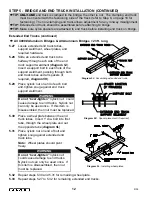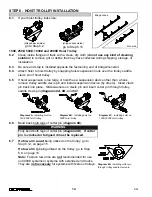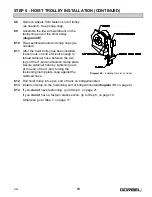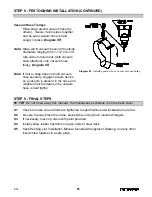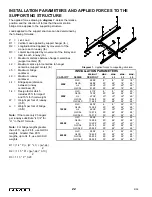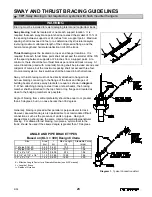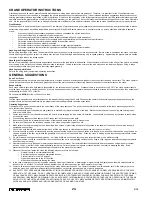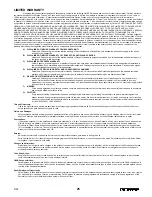
CRANE OPERATOR INSTRUCTIONS
Overhead cranes and jib cranes generally handle materials over working areas where there are personnel. Therefore, it is important for the Crane Operator to be
instructed in the use of the crane and to understand the severe consequences of careless operation. It is not intended that these suggestions take precedence over
existing plant safety rules and regulations or OSHA regulations. However, a thorough study of the following information should provide a better understanding of safe
operation and afford a greater margin of safety for people and machinery on the plant floor. It must be recognized that these are suggestions for the Crane Operator’s
use. It is the responsibility of the owner to make personnel aware of all federal, state and local rules and codes, and to make certain operators are properly trained.
Qualifications
Crane operation, to be safe and efficient, requires skill: the exercise of extreme care and good judgment, alertness and concentration, and rigid adherence to proven
safety rules and practices as outlined in applicable and current ANSI and OSHA safety standards. In general practice, no person should be permitted to operate a
crane:
•
Who cannot speak the appropriate language or read and understand the printed instructions.
•
Who is not of legal age to operate this type of equipment.
•
Whose hearing or eyesight is impaired (unless suitably corrected with good depth perception).
•
Who may be suffering from heart or other ailments which might interfere with the operator’s safe performance.
•
Unless the operator has carefully read and studied this operation manual.
•
Unless the operator has been properly instructed.
•
Unless the operator has demonstrated his instructions through practical operation.
•
Unless the operator is familiar with hitching equipment and safe hitching equipment practices.
Handling the Bridge Travel Motion
Before using the bridge of the crane, the operator should be sure the hook is high enough to clear any obstruction. Before a load is handled by the crane, the bridge
should be brought into position so that it is directly over the load. Start the bridge slowly and bring it up to speed gradually. Approaching the place where it is desired
to stop the bridge, reduce the bridge speed.
Handling the Trolley Motion
Before a load is handled, the hoist should be positioned directly over the load that is to be handled. When the slack is taken out of the slings, if the hoist is not directly
over the load, bring it directly over the load before hoisting is continued. Failure to center the hoist over the load may cause the load to swing upon lifting. Always
start the trolley motion slowly and reduce the trolley speed gradually.
Handling the Hoist Motion
Refer to the lifting (hoist) equipment’s operating instructions.
GENERAL SUGGESTIONS
Know Your Crane
Crane operators should be familiar with the principal parts of a crane and have a thorough knowledge of crane control functions and movements. The crane operator
should be required to know the location and proper operation of the main conductor disconnecting means for all power to the attachments on the crane.
Responsibility
Each crane operator should be held directly responsible for the safe operation of the crane. Whenever there is any doubt as to SAFETY, the crane operator should
stop the crane and refuse to handle loads until: (1) safety has been assured or (2) the operator has been ordered to proceed by the supervisor, who then assumes all
responsibility for the SAFETY of the lift.
Do not permit
ANYONE
to ride on the hook or a load.
Inspection
Test the crane movement and any attachments on the crane at the beginning of each shift. Whenever the operator finds anything wrong or apparently wrong, the
problem should be reported immediately to the proper supervisor and appropriate corrective action taken.
Operating Suggestions
One measure of a good crane operator is the smoothness of the crane operation. The good crane operator should know and follow these proven suggestions for
safe, efficient crane handling.
1.
The crane should be moved smoothly and gradually to avoid abrupt, jerky movements of the load. Slack must be removed from the sling and hoisting ropes
before the load is lifted.
2.
Center the crane over the load before starting the hoist to avoid swinging the load as the lift is started. Loads should not be swung by the crane to reach areas
not under the crane.
3.
Crane-hoisting ropes should be kept vertical. Cranes shall not be used for side pulls.
4.
Be sure everyone in the immediate area is clear of the load and aware that a load is being moved.
5.
Do not make lifts beyond the rated load capacity of the crane, sling chains, rope slings, etc.
6.
Make certain that before moving the load, load slings, load chains, or other lifting devices are fully seated in the saddle of the hook with hook latch closed (if
equipped with hook latch).
7.
Check to be sure that the load and/or bottom block is lifted high enough to clear all obstructions when moving boom or trolley.
8.
At no time should a load be left suspended from the crane unless the operator has the push button with the power on, and under this condition keep the load as
close as possible to the floor to minimize the possibility of an injury if the load should drop. When the crane is holding a load, the crane operator should remain
at the push button.
9.
Do not lift loads with sling hooks hanging loose. If all sling hooks are not needed, they should be properly stored, or use a different sling.
10. All slings or cables should be removed from the crane hooks when not in use (dangling cables or hooks hung in sling rings can inadvertently snag other objects
when the crane is moving).
11. Operators shall not carry loads and/or empty bottom blocks over personnel. Particular additional caution should be practiced when using magnet or vacuum
devices. Loads, or parts of loads, held magnetically could drop. Failure of power to magnets or vacuum devices can result in dropping the load. Extra
precaution should be exercised when handling molten metal in the proximity of personnel.
12. Whenever the operator leaves the crane the following procedure should be followed:
• Raise all hooks to an intermediate position.
• Spot the crane at an approved designated location.
• Place all controls in the “off” position.
• Open the main switch to the “off” position.
• Make visual check before leaving the crane.
13. In the case of emergency or during inspection, repairing, cleaning or lubrication, a warning sign or signal should be displayed and the main switch should be
locked in the “off” position. This should be done whether the work is being done by the crane operator or by others.
14. Contact with rotation stops or trolley end stops shall be made with extreme caution. The operator should do so with particular care for the safety or persons
below the crane, and only after making certain that any persons on the other cranes are aware of what is being done.
15. ANY SAFETY FEATURES AND MECHANISMS BUILT-IN OR OTHERWISE PROVIDED WITH THE CRANE BY GORBEL ARE REQUIRED FOR THE SAFE
OPERATION OF THE CRANE. DO NOT, UNDER ANY CIRCUMSTANCES, REMOVE OR OTHERWISE IMPAIR OR DISABLE THE PROPER FUNCTIONING
OF ANY CRANE SAFETY MECHANISMS OR FEATURES BUILT-IN OR OTHERWISE PROVIDED BY GORBEL FOR SAFE OPERATION OF THE CRANE.
ANY REMOVAL, IMPAIRMENT OR DISABLING OF ANY SUCH SAFETY MECHANISMS OR FEATURES OR OTHER USE OR OPERATION OF THE CRANE
WITHOUT THE COMPLETE AND PROPER FUNCTIONING OF ANY SUCH SAFETY MECHANISMS OR FEATURES AUTOMATICALLY AND IMMEDIATELY
VOIDS ANY AND ALL EXPRESS AND IMPLIED WARRANTIES OF ANY KIND OR NATURE.
24
9/05
Summary of Contents for AL 1000
Page 1: ......



